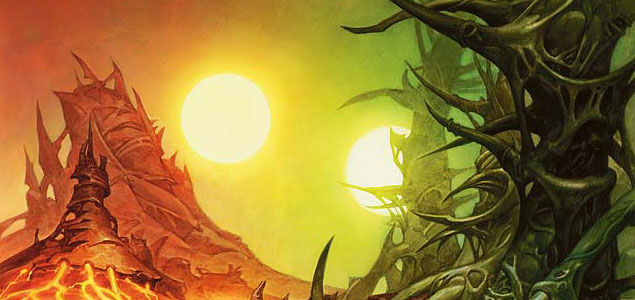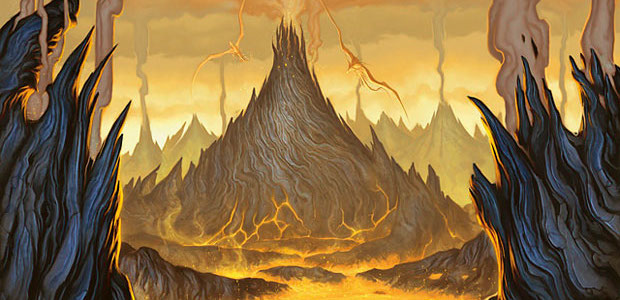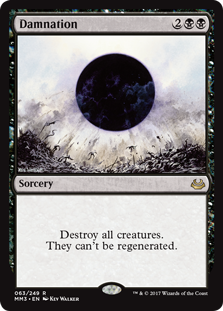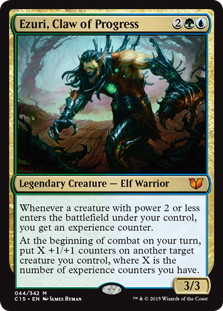Welcome readers to another edition of Uncompetitive Spirit! In my previous article, which you can find by following this link here: CLICK, I described the format of Planechase EDH, or at least the way my particular group plays it. From the comments below that article, and other feedback I received, it seems we're not alone in the "shared planes deck" kind of ruleset, that seems to be the norm, in fact. In this article, I will break down the pros and cons of this format variant, I will break down some basic strategies and how they differ from regular EDH, and then it's finally time to throw Ezuri, Claw of ProgressEzuri, Claw of Progress into the Uncompetitive Arena. Cue heavy metal riff of choice.

The Pros of Planechase EDH
I covered this somewhat in my previous article, but it's worth reiterating and expanding upon. There are a number of reasons to add these cards to your standard game of EDH:
- Flavor. Planechase EDH is a very flavorful format variant, if that is your sort of thing. The plane cards themselves are in many instances bestowed with fantastic pieces of artwork, courtesy of their bigger size than regular Magic cards. If you've never seen them in person and if you happen to find someone who has these cards, take a moment and leaf through them.
- Variance. This isn't everyone's cup of tea. Planechase EDH is even more random than regular EDH, which is way too random for some people. If you're the sort of player who enjoys a more competitive-style EDH game with cutthroat decks duking it out to see who can combo out first or destroy everyone's lands first or the like, then Planechase isn't for you. I'm not saying that there's anything wrong with this, just that the added layer of variance will likely just feel frustrating for your playgroup. If, on the other hand, you play in a more relaxed environment in a more casual playgroup, then this might fit your playgroup very well. The added layer of variance will add excitement to the game that wasn't there before.
- Rubberband effects. Many of the planes that are available have a "rubberband effect" in that it allows for some players to catch-up to their opponents if they are behind. Flipping a certain plane can overthrow the entire board state and completely change the focus of the game. This can be frustrating, but overall the fact that this can happen adds to the sense of agency of players who are far behind on their board states, and this is overall a good thing.
- Activity. Rolling the planar die the first time is free. The second time it costs 1, the third it costs 2 and so on. This can be done as many times as you want, and this means that even if you're sitting with an empty board and topdecking lands you have something to do and actually spend your mana on. This is a great thing, because even though it's a pretty bad spot to be in, it feels like you're doing something and it's less miserable than in regular EDH.

The Cons of Planechase EDH
There are not as many downsides to Planechase EDH as upsides, but they are relevant.
- Exclusivity. The plane cards are a bit difficult to come by and might set you back a considerable amount of cash that could be used to purchase other cards for your deck. If you're interested in the format, I recommend chipping in with your friends and buy the plane cards together. You will play with them together anyway.
- Time. Planechase EDH can get really slow if you flip the wrong kinds of planes and keep rewinding the game. To remedy this, I refer to my earlier article on the format variant - use fewer planes from the "destructive planes" list if you're worried the games will last all night.
- Randomness. As I've stated before, the variance can be frustrating for some players, especially people who lean towards the competitive side of the format, but really for anyone. Having your winning board position neutralized by someone hitting the planeswalk side on the die is a certain feeling. Then again, saving the table from getting rolled by doing just that is pretty awesome.
- Narrow scope. Planechase EDH works best if everyone plays decks that at least want to play creatures and swing with them in some fashion. Tokens going wide, voltron commanders suiting up, it's all good - but combo decks that just want to storm out will find little to nothing of value in Planechase. For an enjoyable game, I suggest playing interactive creature-based decks.

Tactics in Planechase EDH
For the most part, Planechase EDH plays out a lot like regular EDH when it comes to tactics and politics, but there is a big exception: the planar die. This little bargaining chip can be used in tandem with any other politics you're accustom to, and it can be worked both with and against players. In general, unless you're definitely gaining something from the current plane, it's often a good idea to roll the die. If there is a plane that clearly everyone benefits from, such as MinamoMinamo or Eloren WildsEloren Wilds, it can be a good idea to refrain from rolling the die but also to make sure that you let opponents later in the turn order know that you're doing that to allow them a chance to benefit from the plane. Conversely, having an annoying plane, say PrahvPrahv on top of the planar deck can benefit you if you're in a bad position. Consider phrases like "All right, I will try and get us out of here instead of using my mana to play my DamnationDamnation, but you have to promise me you won't attack me for a turn.", assuming your opponents don't know if you have or have not a DamnationDamnation in hand.
There are numerous ways to use this to your advantage and gain political street cred in a game of Planechase EDH, and this I find is another neat upside - the planes themselves spark more communication.
And that's about it. The most important factor of Planechase EDH is to not take it too seriously. This is a very casual variant of an already casual format. Get into the right mindset, break out your creature deck, and start walking some planes!

Uncompetitive Arena: Ezuri, Claw of Progress
When Ezuri, Claw of ProgressEzuri, Claw of Progress, Ezuri 2.0 as it were, was first spoiled I was rather unimpressed. In my eyes, he was another blue-green commander supporting a weenie strategy, and he was more expensive than the already stellar Edric, Spymaster of TrestEdric, Spymaster of Trest. Since then Edric has far been surpassed by Ezuri 2.0, who is now by far the most popular blue-green commander on this site, with over 500 more decks than the runner-up. Ezuri 2.0 supports a wide variety of creature-based strategies, which is part of what makes him so popular in my opinion. If you want to go Infect, you can go Infect and people will hate you. If you want to build tokens, you can build tokens. If you want to play with counters, you can play with counters, and so on. Ezuri 2.0 also has an easier time reloading from a board wipe than Edric, who can be left in the dust if hit by a Supreme VedrictSupreme Vedrict too early.
In this case we're looking at the average deck generated by EDHREC to see how well Ezuri 2.0 would fare in a game of Planechase EDH.
Ezuri EDHREC generated
View on ArchidektCommander (1)
- 1 Ezuri, Claw of ProgressEzuri, Claw of Progress
Creatures (36)
- 1 Acidic SlimeAcidic Slime
- 1 Avenger of ZendikarAvenger of Zendikar
- 1 Bane of ProgressBane of Progress
- 1 Blighted AgentBlighted Agent
- 1 Champion of LambholtChampion of Lambholt
- 1 Chasm SkulkerChasm Skulker
- 1 Coiling OracleCoiling Oracle
- 1 Cold-Eyed SelkieCold-Eyed Selkie
- 1 Cultivator of BladesCultivator of Blades
- 1 Edric, Spymaster of TrestEdric, Spymaster of Trest
- 1 Elvish MysticElvish Mystic
- 1 Eternal WitnessEternal Witness
- 1 Fathom MageFathom Mage
- 1 Forgotten AncientForgotten Ancient
- 1 Gyre SageGyre Sage
- 1 Herald of Secret StreamsHerald of Secret Streams
- 1 Hooded HydraHooded Hydra
- 1 Hornet QueenHornet Queen
- 1 Kaseto, Orochi ArchmageKaseto, Orochi Archmage
- 1 Llanowar ElvesLlanowar Elves
- 1 Master BiomancerMaster Biomancer
- 1 MulldrifterMulldrifter
- 1 MycolothMycoloth
- 1 Mystic SnakeMystic Snake
- 1 Prime Speaker ZeganaPrime Speaker Zegana
- 1 Rashmi, Eternities CrafterRashmi, Eternities Crafter
- 1 Reclamation SageReclamation Sage
- 1 Rishkar, Peema RenegadeRishkar, Peema Renegade
- 1 Sage of HoursSage of Hours
- 1 Sakura-Tribe ElderSakura-Tribe Elder
- 1 Simic ManipulatorSimic Manipulator
- 1 Solemn SimulacrumSolemn Simulacrum
- 1 ThrummingbirdThrummingbird
- 1 Trygon PredatorTrygon Predator
- 1 Vorel of the Hull CladeVorel of the Hull Clade
- 1 Zameck GuildmageZameck Guildmage
Instants (8)
- 1 ArachnogenesisArachnogenesis
- 1 Beast WithinBeast Within
- 1 CounterspellCounterspell
- 1 Cyclonic RiftCyclonic Rift
- 1 Inspiring CallInspiring Call
- 1 Krosan GripKrosan Grip
- 1 Plasm CapturePlasm Capture
- 1 Rapid HybridizationRapid Hybridization
Sorceries (6)
- 1 CultivateCultivate
- 1 Green Sun's ZenithGreen Sun's Zenith
- 1 Kodama's ReachKodama's Reach
- 1 Rampant GrowthRampant Growth
- 1 Rishkar's ExpertiseRishkar's Expertise
- 1 Verdant ConfluenceVerdant Confluence
Artifacts (7)
- 1 Bident of ThassaBident of Thassa
- 1 Lightning GreavesLightning Greaves
- 1 PanharmoniconPanharmonicon
- 1 Simic SignetSimic Signet
- 1 Sol RingSol Ring
- 1 Swiftfoot BootsSwiftfoot Boots
- 1 Thought VesselThought Vessel
Enchantments (5)
- 1 Beastmaster AscensionBeastmaster Ascension
- 1 Fable of Wolf and OwlFable of Wolf and Owl
- 1 Growing Rites of ItlimocGrowing Rites of Itlimoc
- 1 Hardened ScalesHardened Scales
- 1 Inexorable TideInexorable Tide
Planeswalkers (1)
- 1 Nissa, Voice of ZendikarNissa, Voice of Zendikar
Lands (36)
- 1 Command BeaconCommand Beacon
- 1 Command TowerCommand Tower
- 1 Evolving WildsEvolving Wilds
- 1 Hinterland HarborHinterland Harbor
- 1 Mosswort BridgeMosswort Bridge
- 1 Novijen, Heart of ProgressNovijen, Heart of Progress
- 1 Oran-Rief, the VastwoodOran-Rief, the Vastwood
- 1 Reliquary TowerReliquary Tower
- 1 Simic Growth ChamberSimic Growth Chamber
- 1 Simic GuildgateSimic Guildgate
- 1 Temple of MysteryTemple of Mystery
- 1 Terramorphic ExpanseTerramorphic Expanse
- 1 Thornwood FallsThornwood Falls
- 1 Yavimaya CoastYavimaya Coast
- 9 IslandIsland
- 13 ForestForest
As we can see, the +1/+1 counters subtheme shines through in the EDHREC average deck. The deck looks pretty well tuned, actually, with many powerful synergies between the commander and cards like Chasm SkulkerChasm Skulker, Herald of Secret StreamsHerald of Secret Streams, Master BiomancerMaster Biomancer, and Sage of HoursSage of Hours to name just a handful. It is blessed with the regular green ramp package, as well as a few select instants to interact with permanents. A single CounterspellCounterspell constitutes the deck's countermagic package, but Ezuri prefers to be proactive rather than reactive. If tuned properly, I reckon at least a couple more counterspells to deal with board wipes and other nasty surprises would be reasonable.
These strengths combined make Ezuri an excellent choice for Planechase EDH. There are a lot of planes in the list which benefits his strategies since many of them constructively interact with creatures. Just imagine flipping GoldmeadowGoldmeadow, playing a fetchland, cracking it for another land and casting CultivateCultivate - this would equal nine experience counters if Ezuri is in play. This does sound like Magical Christmas Land, but it is that type of silliness that happens regularly in Planechase EDH.
Closing words
Planechase EDH is not for the faint of heart, but it is very fun and can bring lots of action to otherwise very straight games of EDH. If you're feeling brave enough, put on your best Jace cloak and light that spark! Until next time, stay awesome and keep it casual!
Robin Kaas
Robin started playing Magic in secondary school, around Urza block, and has spent his entire time in the game with non-rotating formats. In his past, Robin was a diehard competitive tournament player, but he has shifted to playing EDH/Commander and Limited almost exclusively in the past years. He works as a development manarger in charge of democracy development, and lives in Sweden with his wife and his daughter.
Your opinions are welcome. We love hearing what you think about Magic! We ask that you are always respectful when commenting. Please keep in mind how your comments could be interpreted by others. Personal attacks on our writers or other commenters will not be tolerated. Your comments may be removed if your language could be interpreted as aggressive or disrespectful. You may also be banned from writing further comments.
